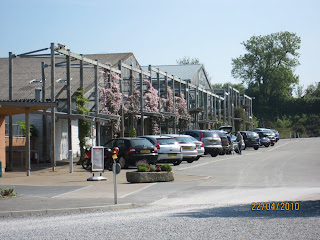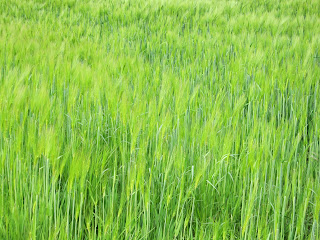 David Jenkinson outside the feeding sheds, Broadwell Manor Farm
David Jenkinson outside the feeding sheds, Broadwell Manor Farm Silage pit covered with plastic and tyres, but a new recycled rubber mat will soon replace tyres
Silage pit covered with plastic and tyres, but a new recycled rubber mat will soon replace tyres High capacity slurry tank and collection area behind the dairy milking parlour
High capacity slurry tank and collection area behind the dairy milking parlour Examining root growth on seedlings of spring sown wheat
Examining root growth on seedlings of spring sown wheat A crop of winter wheat (sown in autumn 2009) plus trusty dog
A crop of winter wheat (sown in autumn 2009) plus trusty dog A minimum disturbance disc seeder used for crops and pastures
A minimum disturbance disc seeder used for crops and pasturesBroadwell Manor Farm covers nearly 1300 acres near Lechlade in Gloucestershire. Part of the farm covers an old WW2 airfield with the control tower and runways still visible, though not very productive for agriculture. In an area noted for the home of the headwaters of the River Thames and a fly fishing mecca due to its abundance of suitable gravel lakes, the farm is located between three small villages. Milking 120-150 cows year round, it produces milk for the company that supplies Sainsburys supermarkets.
The farm uses the grain produced by its cropping activities to feed the dairy cows. Maize, winter wheat (sown in autumn), winter barley, winter oilseed rape and spring wheat add either to the protein and energy needs of the cows or their fibre or bedding requirements. Some grain can be sold on for milling but most is retained. Silage clamps or pits are filled and used annually and the farm is moving to replace the plastic and tyre covers with recycled rubber holey matting. This matting is made from shredded tyres and waste rubber and is heavy but inert. There is a careful rotation of the different crops in order to meet nutritional needs of the cows and efficiently use the arable area. Fertilisers, including treated human sewage waste, are incorporated into the soil at regular intervals.
Black-faced "mule" sheep ( a crossbred prime lamb mother) are run as an additional livestock activity. The sheep produce a high percentage of twins which are aimed for the 20-22kg market. The ewes lamb in February and whilst the lambs don't make the lucrative early lamb prices, management of mating (in autumn months) is considerably easier. Early lambs are conceived in summer months when the natural fertility of the ewe is lower than in autumn. Photo periodicty at work again. The sheep are used to clean up paddocks in preparation for sowing, as weed control agents and to graze land unsuitable or too remote for the dairy herd. A late start to spring and continued dry weather has meant that David has less available grazing land for the sheep than would normally be the case.
The farm is a LEAF demonstration farm, opening up for Farm Sunday in June when townsfolk and people who seldom walk onto a farm are openly invited to have a closer look at agriculture. David expects tens to hundreds of people to walk through the dairy yards and have a tractor and trailer ride and to get a better idea of the process of producing milk. He had a number of stories of previous farm visits by schoolchildren including one young boy asking him where the milk powder was fed to the cows to get the milk.
The farm management strategy has been to retain and maintain the hedgerows and wooded areas to encourage populations of birds, bugs and predators. Crop margins are preserved and an area of cleared space near hedgerows provides the owners with a game bird area each shooting season.
David was a helpful host, understated but determined to provide the correct growing environment for the animals, crops and pastures under his management. The farm co-existed with neighbouring houses and residents and seemed to be producing milk, lamb and crops efficiently and effectively.






















